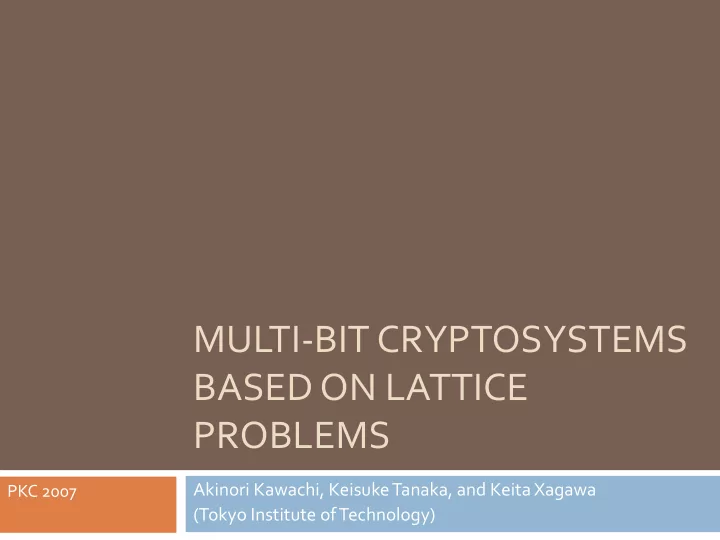

MULTI-BIT CRYPTOSYSTEMS BASED ON LATTICE PROBLEMS Akinori Kawachi, KeisukeTanaka, and Keita Xagawa PKC 2007 (Tokyo Institute ofTechnology)
Agenda Background Our Results Conclusion
Agenda Background Lattices Lattice problems Lattice-based cryptosystems Motivation Our Results Conclusion
Lattices Given: B =[ b 1 ,..., b n ] L( B ) := {Σ i α i b i | α i ∈ Z for all i} L b 1 b 2 0
SVP (ShortestVector Problem) SVP: Given a basis B of a lattice L, find a shortest non-zero vector v in L b 1 2 b 1 -3 b 2 b 2 0
uSVP (unique ShortestVector Problem) v: 2-unique v 0
Hardness of uSVP If f < g, f-uSVP is not easier than g-uSVP v :g-unique v :f-unique f=1 NP-hard [Kumar and Sivakumar ‘01] f=n 1/4 coAM (seems not NP-hard) [Cai ‘98] f=poly(n) ? Assumption: If f=poly(n), f-uSVP is intractable in the worst-case
Lattice-BasedCryptosystems Based on lattice problems SVP, uSVP, CVP, and etc Advantages Fast encryption and decryption (Seemes) hard to attack with quantum power Two types TypeA: efficient, but no security proofs Type B: security proofs, but inefficient
RelatedWorks Type A Type B AD [Ajtai and Dwork ’97] GGH AD GGH (Errorless version of AD cryptosystem) [Goldreich, Goldwasser, and Halevi ‘98] [Goldreich, Goldwasser, and Halevi ‘98] NTRU [Hoffstein, Pipher, and Silverman ‘98] Regev04 [Regev ‘04] Regev05 Ajtai 05 [Regev ’05] [Ajtai ’05]
Type B AD GGH , Regev04, Regev05, and Ajtai05 Advantage Provable security with average-case/worst-case connection (except Ajtai05) Disadvantages |pk| is huge |plaintext|=1
Motivation Towards practical lattice-based cryptosystems in Type B 1. |pk| small 2. |plaintext| large w/o changing |cipher|
Agenda Background Our Results Summary Review of Regev04 Our technique Analysis of trade-off Pseudohomomorphism Conclusion
Our Results Results Proposal of multi-bit versions ofType B AD GGH , Regev04, Regev05, and Ajtai05 Analysis of the trade-off between the size of plaintext and security levels Pseudohomomorphism AD GGH , Regev04, Regev05, and Ajtai05
Eg: Regev04 Security parameter: n n is the dimension of lattices Key Generation Encryption Decryption Decryption Errors Security Reduction
Regev04 - Key Generation 1 Choose private priod d Consider periodic Gaussian distrib. with variance α 2 Probability N=2 8n2 0 d
Regev04 - Key Generation 2 Choose a 1 ,…,a m according to the distribution 0 N
Regev04 - Key Generation 3 Decide the index k a k /2 must be in “bottom” 0 N a k /2 a k
Regev04 - Key Generation 4 Secret Key: d Public Key: a 1 ,…,a m ,k 0 d N a k /2 a k
Regev04 - Encryption of “0” r ∈ R {0,1} m E(0) = Σ i r i a i mod N 0 d N
Regev04 - Encryption of “1” r ∈ R {0,1} m E(1) = a k /2 + Σ i r i a i mod N 0 d N a k /2
Regev04 - Decryption 1 Received ciphertext is c ∈ {0,…,N -1} Consider c mod d 0 d
Regev04 - Decryption 2 Decrypt to “0” 0 d
Regev04 - Decryption 3 Decrypt to “1” 0 d
Regev04 - Decryption Errors Consider c mod d 0 d
Regev04 - Security E(0) vs. E(1) with pk E(0) vs. U with pk E(0) vs. U with pk O(n/α) -uSVP in the worst case α 2 is the variance of distrib. in key generation 0 d N a k /2
Regev04 - Security E(0) vs. E(1) with pk E(0) vs. U with pk E(0) vs. U with pk O(n/α) -uSVP in the worst case α 2 is the variance of distrib. in key generation O(n/α) -uSVP in the worst case 0 d N a k /2
OurTechnique #plaintext : 2 p Increase # of “waves” Same |ciphertext| and |pk|
Multi Bit - Illustration E(0): Blue E(1): Green 0 d
Multi Bit - Illustration Increase # of “waves” with a k =(p+1)d+e 0 d a k /p
Multi Bit - Illustration make “waves” thin to decrease decrytpion errors Variance: α 2 ( α/p) 2 in key generation 0 d a k /p
Multi Bit - Illustration Variance: α 2 ( α/p) 2 Underlying Problem: O(n/α) -uSVP O(pn/α) -uSVP 0 d a k /p
Comparison Regev04 Ours plaintext 1 log p 8n 2 ciphertext Õ(n 4 ) public key Õ(n 2 ) secret key Õ(n 1.5 )-uSVP Õ( p n 1.5 )-uSVP security
Comparison - 2 AD GGH Ours Regev04 Ours plaintext 1 log p 1 log p O(n 11 )- O( p n 11 )- Õ(n 1.5 )- Õ( p n 1.5 )- security uSVP uSVP uSVP uSVP Regev05 Ours Ajtai05 Ours plaintext 1 log p 1 log p SVP Õ(n1.5) SVP Õ( p n1.5) DA DA’ security
Homomorphism of PKE E(m)+E(m’)=E(m+m’) cf. RSA, Goldwasser-Micali,... Do R04 and ours have homomorphism? No Pseudo-homomorphism
Pseudo-homomorphism D(blue)=0, D(green)=1 D(blue+green)=1 , D(green+green)=0 0 d a k /2 mod d
Conclusions Results Proposal of multi-bit versions ofType B AD GGH , Regev04, Regev05, and Ajtai05 Analysis of the trade-off between the size of plaintext and security levels Pseudo-homomorphism AD GGH , Regev04, Regev05, and Ajtai05 Open Problem Q (n)-bit cryptosystems with a/w connection We develop O(log n)-bit cryptosystems with a/w It may require new idea
Recommend
More recommend